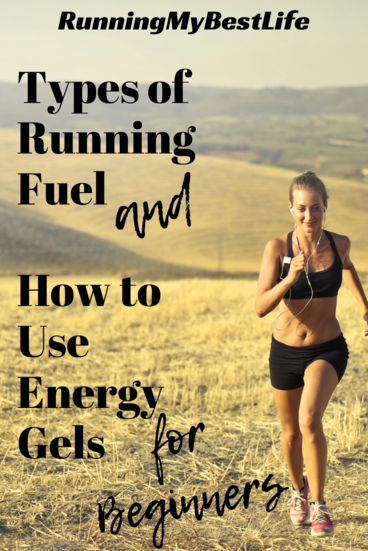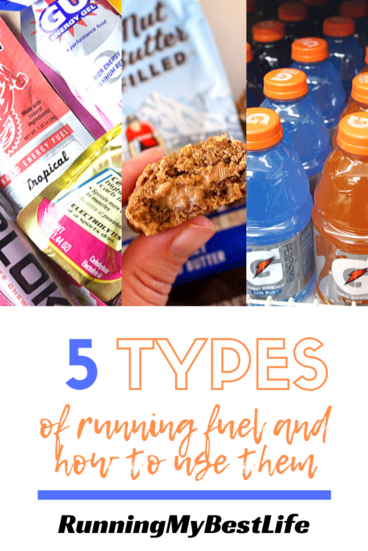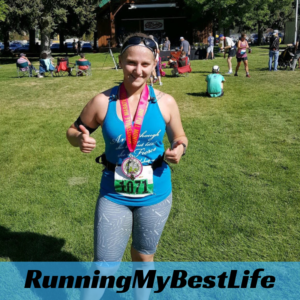With several different types of running fuel available on the market today, it can be confusing to determine what types of running fuel you need, and when to use it.
In fact, do you know when to start using fuel in the first place or why you need it? Let’s start with the “why.”

Why Do Runners Need Race Fuel?
Have you ever heard of the dreaded “Wall”?
I’m talking about the one runners hit over halfway through a marathon or half marathon, when their legs just seem to quit working.
When we run, we burn a mix of stored carbohydrates and stored fat. Our bodies can store plenty of fat to fuel a marathon, but carbohydrates are stored in our muscles in the form of glycogen. And the amount of glycogen we can store is limited.
There is nothing worse than speeding through a tough race, only to find out that you have no fuel left in the tank long before you reach the finish line. The effect of this is very similar to running out of gas in your car—you are basically running on fumes as you slow down and stop, because your body doesn’t have the energy (carbohydrates) to keep moving.
Related: The Complete Nutrition Guide on How to Fuel a Half Marathon
When Should You Use Running Fuel?
Most runners can safely run for up to 90 minutes before they need to take in some type of fuel. Any runs shorter than 90 minutes don’t require fuel.
For runs lasting longer than 90 minutes and distance races such as a half or full marathon, carbohydrate intake of 30-60 grams per hour is recommended.
“Most runners should consume at least 30 grams of carbohydrate per hour to see benefits. As much as 60 grams and even up to 90 grams per hour can be beneficial in longer races”
The New Rules of Marathon and Half Marathon Nutrition by Matt Fitzgerald
Matt Fitzgerald also notes that many runners cannot stomach more than 60 grams of carbs per hour. If you are new to the fueling game, start out with less. For beginners introducing running fuel to your regimen, shoot for around 30 grams per hour of carbohydrate intake as a starting point.
Once your stomach is used to 30 grams, you can add more.
For newer runners working to increase their long run mileage, you don’t need any running fuel for 6 miles or less. Over 6 miles, I recommend adding a quality sports drink between 6-8 miles.
How to Use Running Nutrition and Fuel
Runs 9 miles or longer is when you can start adding a gel or two. On these runs, I add a gel starting at 40-45 minutes, and around every 30-45 minutes after that. This will take some experimentation to find out what works best for your body.
Try different types of fuel, and practice using them at longer or shorter intervals to see how your body responds.
Your long training runs are the best time to experiment with different combinations of fuels and sports drink. By race day, you want to narrow down your experiments to the strategy where you feel the best. Don’t try anything new on race day—you really don’t want to risk ruining an awesome race with an upset stomach (or worse—the runner’s trots!)
Related: 3 Powerful Fueling Strategies for Your Half Marathon

Types of Running Energy Fuel and Nutrition for Beginners
The beautiful thing about many different types of running fuel is that you have several different options, so if one option doesn’t agree with you, there are different types of fuel to turn to.
The bad thing about many different types of running fuel is…where to start? When you start exploring the world of running energy gels for beginners, there can be a lot of options and information to take in.
We’ll start with the most common option, which you might already be aware of.
Sports Energy Drink
The “energy” in the “energy drink” that runners refer to doesn’t mean a super-caffeinated Monster or Rockstar drink. The “energy” we refer to is literally the carbohydrates that allow us to run for hours on end.
Gatorade and Powerade are mass marketed versions of energy drinks and chances are, you’ve probably already tried one of those. The drawback to drinks like Gatorade is that they use high fructose corn syrup, which is far from the cleanest fuel runners can use.
A good sports energy drink also has electrolytes to help keep you balanced and replace minerals lost through sweat.
Recommendations:
Energy Gels
Gels are one of the most popular forms of carbohydrate sources for distance runners. Running energy gels are typically where beginners start when looking for running nutrition.
They are simple, convenient, and fairly quick to use. They are typically the best option if you need a quick shot of carbohydrate without fumbling around with chews or bars.
On the downside, gels are most likely to mess with your stomach. To avoid serious stomach upset, I stick with Huma or Honey Stinger. That being said, Gu is the most popular type of running energy gel for beginners.
Recommendations:
Energy Chews
Energy chews are like fancy fruit snacks. They basically contain the same nutrition that you would get from a gel, only in a more solid form. If you need to actually chew on something rather than just slurping down a gel or sports drink all day, then you might want to try out some energy chews or blocks.
Recommendations:
Energy Bars
If you need to chew something more solid than fruit snacks or you are running for several hours and you want to feel like you are actually eating something, then energy bars are your best bet outside of just eating real food.
The advantage of bars is that they come in a convenient package you can carry with you, and they won’t get messy. However, they can be cumbersome to chew in the middle of a race.
Recommendations:
Energy Waffles
I used to think the whole waffle thing was weird, until I tried one. These things are amazing, and they taste like dessert!
What could possibly be better than the deliciousness of honey or caramel sandwiched between two thin waffles? Answer: Nothing. Absolutely nothing.
I look for any excuse to use the waffles including hikes, really long runs, or right before a tough workout. Just like the bars though, it can be cumbersome to chew a waffle in the middle of a race. I like to use waffles when I can slow down to a walk to eat them, or eat them just before a workout for a boost of energy.
Recommendation: Honey Stinger Waffle
What is Your Favorite Type of Running Nutrition?

Run Happy,
Alexis
- Nailing Your Marathon Hydration Strategy: A Comprehensive Guide
- Conquering Marathons in the Cold: A Comprehensive Guide
- Harnessing the Power of Technology for Successful Marathon Training
- Mastering the Marathon: The Ultimate Guide to Nutrition and Training
- Ultimate Guide to the Top 5 Running Shoes for Beginners in 2023
About Me: I’m Alexis, Founder of RunningMyBestLife! I am an avid recreational runner, half marathoner, wife, dog mom, busy professional, downhill skier in Northern Utah. My mission is to help new enthusiasts fall in love with the sport of running. I believe that running is a catalyst to taking control of your life and living your best life by design. Learn More –>
